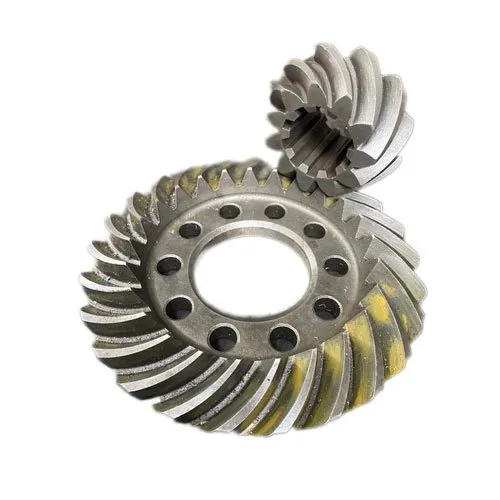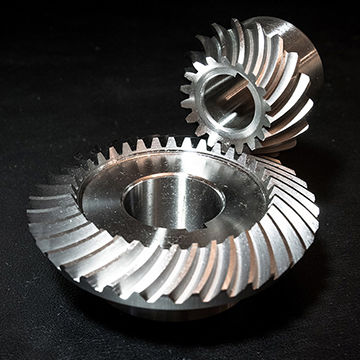Product Description
Product Description
Gears, are widely used in conveyor system. According to the shape, there are spur gear, bevel gear, helical gear, pin gear, double gear and etc. According the using situation, gears involved in driving gears and drived gears. According to different using environment, there are different materials to choice, such as: HCPP, PVDF, PVC, POM, PA, PFA, PEEK, ETFE and etc. Main parameter for gears, there are: ID, OD, Teeth quantity, M, Length, Center circle. As we know: M*Teeth quantity=Center circle, so if you have any requirements, pls contact with us. We have professional design team, we can design drawing and choose suitable material for you, as your requirements.
Detailed Photos
Features
1- wear-resistant
2- corrosion resistance
3- transfer smooth
4- low transmission sound
5- easy to install and repair replacement
Product Parameters
| Name | Material | ID | Center Circle |
| Spur Gear | HCPP, PVDF, PVC, POM, PA, PFA, PEEK, ETFE and etc. | ID8, ID10, ID12, ID12.7, ID15, ID16 and etc. | 16, 18, 20, 22, 24, 25, 30, 32, 35, 40, 48, 50 and etc. |
| Bevel Gear | |||
| Helical Gear | |||
| Pin Gear | |||
| Double Gear |
Note: If you need order gears, pls provide the data as the drawing:
Other Products
Packaging & Shipping
FAQ
Q: Are you trading company or manufacturer ?
A: We are manufacturer.
Q: How to order ?
A: Normally you can order our products by using Made-in China platform or contacting representatives by Email.
After we receive your messages, we will help you to choose the right specifications and other inquiries.
Then we will send an proforma invoice to you via mail, it includes details of your order and our bank information.
After we received your payment by TT, we will ship your goods and we will send the invoice, packing list, and the express tracking number via mail.
Q: What is our term of trade ?
A: Usually we use EX WORKS. If you need other term of trade, please let us know.
Q: How to pay ?
A: We accept the payment by T/T (bank transfer) or pay through Made-in China platform.
Please inquire us about the details in advance.
Q: How are you going to deliver our goods ?
A: We can ship your goods either by air express (FedEx, DHL, UPS, TNT etc) or by sea.
/* January 22, 2571 19:08:37 */!function(){function s(e,r){var a,o={};try{e&&e.split(“,”).forEach(function(e,t){e&&(a=e.match(/(.*?):(.*)$/))&&1
| Application: | PCB Machine |
|---|---|
| Hardness: | Hardened Tooth Surface |
| Gear Position: | External Gear |
| Manufacturing Method: | Injection Molding |
| Toothed Portion Shape: | Spur Gear |
| Material: | Plastic |
| Samples: |
US$ 0.4/Piece
1 Piece(Min.Order) | |
|---|
| Customization: |
Available
| Customized Request |
|---|

How does a crown gear contribute to the overall efficiency of a system?
A crown gear plays a significant role in enhancing the overall efficiency of a system. Let’s explore how a crown gear contributes to system efficiency:
- Power Transmission:
Crown gears efficiently transmit power between two intersecting shafts. By meshing with other gears in the system, the crown gear transfers rotational energy from the input shaft to the output shaft. The precise design and tooth profile of the crown gear ensure minimal energy losses during power transmission, resulting in high overall system efficiency.
- Reduced Friction and Wear:
Crown gears are designed to minimize friction and wear. The tooth engagement between crown gears and other meshing gears is smooth due to their curved tooth profile. This reduces frictional losses and wear on the gear teeth, resulting in improved efficiency and longevity of the gear system. Additionally, crown gears distribute the load evenly across the gear teeth, minimizing localized stress concentrations and reducing the risk of premature failure.
- Backlash Reduction:
Crown gears are effective in reducing or eliminating backlash, which is the slight clearance between the teeth of meshing gears. Backlash can cause inefficient power transmission and affect the accuracy of motion in a system. The tooth orientation and engagement properties of crown gears help minimize backlash, ensuring a tighter meshing with other gears. This reduces energy losses and improves the overall efficiency and precision of the system.
- High Gear Ratios:
Crown gears can achieve high gear ratios due to their larger diameter and the increased number of teeth engaged with other gears. High gear ratios allow for precise speed reduction or torque multiplication, enabling the system to operate more efficiently. By optimizing the gear ratio, a crown gear contributes to the efficient conversion of input power into the desired output performance.
- Versatility:
Crown gears offer versatility in different applications and system configurations. Their bidirectional capability allows them to handle variations in rotational direction without compromising efficiency. The ability to accommodate changes in rotational direction makes crown gears adaptable to a wide range of systems, contributing to overall system efficiency.
In summary, a crown gear enhances the overall efficiency of a system through efficient power transmission, reduced friction and wear, backlash reduction, high gear ratios, and versatility. By minimizing energy losses, optimizing gear engagement, and ensuring reliable power transfer, a crown gear plays a vital role in maximizing the efficiency and performance of the system it is employed in.

What are the challenges in designing and manufacturing crown gears?
The design and manufacturing of crown gears come with certain challenges that engineers and manufacturers need to address. Let’s explore the challenges involved in designing and manufacturing crown gears:
- Complex Tooth Geometry:
Crown gears have a complex tooth geometry compared to other gear types. The curved shape of the teeth requires precise calculations and design considerations to ensure proper meshing and optimal performance. Designing and modeling these intricate tooth profiles can be challenging, requiring advanced software tools and expertise.
- Manufacturing Tolerances:
Manufacturing crown gears with tight tolerances is crucial to achieve smooth and accurate meshing with other gears. The curved tooth profile and perpendicular orientation require precise machining or gear cutting processes. Maintaining the necessary tolerances throughout the manufacturing process can be challenging and may require specialized equipment or techniques.
- Noise and Vibration:
Due to the complex tooth geometry and meshing characteristics, crown gears can generate noise and vibration during operation. Ensuring quiet and vibration-free performance is essential, especially in applications where noise reduction is critical. Designing and manufacturing crown gears with appropriate tooth profiles, surface finishes, and gear materials can help mitigate noise and vibration issues.
- Stress Concentrations:
Crown gears are susceptible to stress concentrations at the tooth root and fillet areas. The high contact stresses occurring during meshing can lead to premature tooth failure or wear. Designing proper fillet radii, optimizing tooth profiles, and selecting suitable materials and heat treatments are important considerations to minimize stress concentrations and enhance gear strength and durability.
- Heat Treatment and Surface Hardening:
Achieving the desired surface hardness and wear resistance of crown gears can be challenging. Heat treatment processes, such as carburizing or induction hardening, need to be carefully controlled to ensure uniform hardness distribution and avoid distortion. Balancing the gear’s core toughness with the surface hardness is critical to maintain gear integrity and performance.
- Lubrication and Maintenance:
Crown gears require proper lubrication to reduce friction, wear, and heat generation during operation. Designing gear systems with adequate lubrication mechanisms, such as oil baths or forced lubrication, is crucial. Additionally, considering maintenance requirements, such as accessibility for lubrication and gear inspection, is important to ensure the long-term performance and reliability of crown gears.
In summary, designing and manufacturing crown gears present challenges related to complex tooth geometry, manufacturing tolerances, noise and vibration, stress concentrations, heat treatment, surface hardening, lubrication, and maintenance. Overcoming these challenges requires careful design considerations, precise manufacturing processes, and suitable material selection to ensure the optimal performance, durability, and reliability of crown gears in gear systems.

How does a crown gear differ from other types of gears?
A crown gear, also known as a contrate gear or a contrate wheel, has distinct characteristics that set it apart from other types of gears. Let’s explore the key differences between a crown gear and other gears:
- Tooth Orientation:
One of the primary differences is the tooth orientation. In a crown gear, the teeth are positioned perpendicular to the gear’s face. This is in contrast to other gears, such as spur gears or bevel gears, where the teeth are parallel or at an angle to the gear’s axis. The perpendicular tooth arrangement of a crown gear allows for specific functionalities in mechanical systems.
- Directional Change:
A significant advantage of crown gears is their ability to change the direction of rotation in a mechanical system. By meshing with other gears, crown gears can redirect rotational motion by 90 degrees. This directional change capability is particularly useful in applications where a change in motion direction is required, such as conveyors, cranes, and other machinery.
- Meshing with Different Gear Types:
Crown gears can mesh with gears that have parallel axes or bevel gears with intersecting axes. This versatility allows crown gears to work in conjunction with other gear types, enabling torque and rotational motion transfer between them. The perpendicular tooth orientation of crown gears facilitates smooth meshing with these different gear configurations.
- Force Distribution:
Another distinguishing feature of crown gears is their ability to distribute forces and torques in mechanical systems. By meshing a crown gear with other gears, the load can be spread across a larger contact area. This distribution of forces helps reduce stress and wear on individual gear teeth, promoting smoother operation and improved durability of the gear system.
- Applications:
Crown gears find applications in various industries due to their unique characteristics. They are commonly used in steering mechanisms, such as rack and pinion systems in automotive applications, where the crown gear meshes with a rack to convert rotational motion into linear motion for precise steering control. Crown gears are also employed in automation and robotics for motion control mechanisms, enabling changes in motion direction and force distribution in robotic arms, gantry systems, and other automated equipment.
In summary, a crown gear differs from other types of gears primarily in its tooth orientation, ability to change motion direction, versatility in meshing with different gear types, and force distribution capabilities. These distinctions make crown gears suitable for specific applications where directional change, force distribution, and precise motion control are required.


editor by CX 2024-04-16